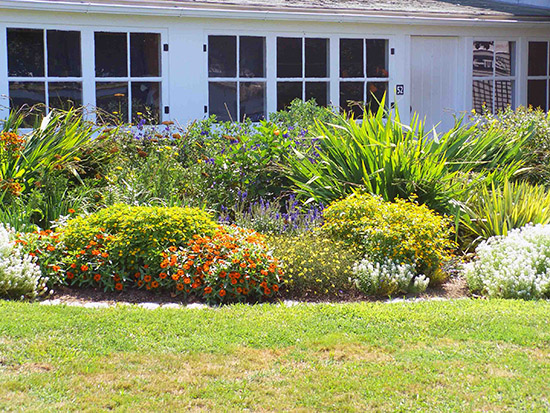Issue 16, October 6, 2014
Planting for Pollinators
The reductions in honey bees and other pollinators in recent years have been making headlines in the mass media. There are a number of factors associated with these declines including loss of habitat, parasites, disease, genetics, poor nutrition, and pesticide exposure. Perhaps the biggest factor is loss of habitat.
Not only are urban areas expanding, eliminating some rural areas, but rural areas appear to have much less habitat for pollinators. The use of the broad-spectrum herbicide glyphosate (Roundup and others) over GMO resistant crops has resulted in fewer "weeds" in crop fields to support pollinators. In addition, farmers appear to be mowing roadsides more than a couple of decades ago, and many broadleaf plants that serve as food sources for pollinators do not survive mowing.
Urban areas are also at fault with many landscapes having been transitioned away from flowering plants. Landscapes that consist of turf along with a few shrubs and trees are easier to maintain. Although some of the trees and shrubs are attractive to pollinators when blooming, they generally don't have as long of a blooming season as annual or perennial flowers. Various media efforts are targeted at reversing this trend. They are encouraging homeowners to include more plants in their landscapes that are pollinator friendly. These efforts result in increased clientele requests for information and plantings of pollinator food plants.

Plants that are attractive to adult pollinating insects have shallow nectaries and abundant pollen. Many annual flowers fit these parameters. In a seed catalog, those annuals listed as being butterfly or bee friendly are good choices. The following trees, shrubs, and perennials are also appropriate and generally require less maintenance than annuals.
American basswood
Pussy willow
Prairie rose
Leadplant
Wild bergamot
Purple giant hyssop
Prairie blazing star
New England aster
Showy goldenrod
Wild lupine
Eastern waterleaf
Spotted geranium
Smooth penstemon
Butterfly milkweed
Purple prairie clover
Eastern purple coneflower
Riddell's goldenrod
A number of the above plants are also appropriate larval food plants such as pussy willow for viceroy butterflies and milkweeds for monarch butterflies. Several trees are food plants for the larvae of several butterflies. Honey bees and other bees feed their larvae pollen and nectar so the above plants also function as larval food plants. Wasps feed insects to their larvae, and the larvae of many adult beetle pollinators are also insect predators. Other pollinator beetle larvae live in rotting wood. (Phil Nixon)
Author:
Phil Nixon